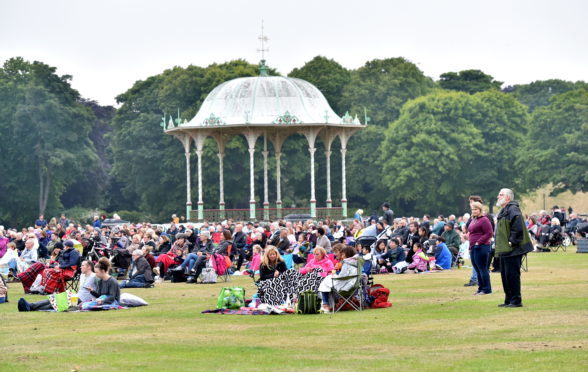Summertime is here again. Long hot sunny days. (Well mostly).
It’s great to see the youngsters running through the water fountains at Marischal Square. Making the most of and enjoying our recent development asset. It’s funny to think many of those who protested about it have joined the tourists and are now enjoying the coffee shops and restaurants as they gaze out onto the world’s second largest granite building.
During the 1950s and 1960s and into the 1970s Aberdeen used to be invaded by Glaswegians and Edinburghers who came north to enjoy the July Fair Fortnight.
In those days it was the long golden sandy beaches, silver granite buildings and the green spaces which attracted visitors. Aberdeen was referred to as the Silver City with the Golden Sands. Articles from the time described how thousands of visitors poured into Aberdeen by road and by rail – on 24 trains, 200 buses, in private cars and by BEA planes. At the height of the season, six trains pulled into the joint railway station at eight-minute intervals and the capacity on each train was 800 people.
Clearly a tourist bonanza that would put Visit Scotland’s poor generic efforts to shame. In fact I do wonder if our current bus and train operators could even begin to manage that volume of people today.
Sea bathing was popular and there were wooden chalets, known as beach bungalows which could be hired for £1 per week. We had the largest swimming pool in Scotland at the time measuring 90 feet by 35 feet and situated on the beach front. There were deck chairs for hire, donkey rides, pleasure beach carnival, talent contests and live entertainment at the Gaiety restaurant and Beach Ballroom.
Sadly its all changed now and most of it has gone. All that remains of these heady days is the Beach Ballroom. An iconic building opened in May 1929 which is dear to the hearts of most Aberdonians. Opened as a dance hall and tea lounge, and today in its 90th year celebrations, it continues to hold dances, concerts, weddings, afternoon teas and so much more. It is well worth hearing john Johnstone, the venue’s manager, talk about its history and special landmarks like the Beatles playing there at the start of their long and famous musical career.
My first recollection of the Beach Ballroom was as a five-year-old lad when I attended, with my older cousin, a large Christmas party event held by the Aberdeen Corporation for children of its employees. I hated it and spent most of the afternoon playing hide and seek rather than the games on offer! As a teenager I used to meet my pals regularly at the Ballroom on a Sunday afternoon to hear the top 20 pop records of the day played by a guy on the stage. A forerunner to a DJ. There was no Radio One then – just Radio Luxemburg or Radio Caroline.
I’ve given many political speeches and civic welcomes there. And in 1986 it was the venue where I wrestled world champion Johnny Saint to a 12 round draw in front of a a packed 1,200 capacity crowd.
Aberdeen is still a great tourist attraction but I do wonder if we could do more to help ourselves.
One Tuesday evening, around 5.30pm, I was strolling down Union Street, with some friends, desperate for something to eat and drink.
Unfortunately most of the shops and cafes were closed. The Music hall restaurant, another of our iconic buildings, was also closed.
I cannot understand why, at the height of the summer tourist trade, our eating places operate on “office” hours, closing at 5pm.
This is why the younger generation prefer the fast foods outlets, because they are nearly always available. Our older shopping precincts still work on old traditions and are shut by 6pm. This is hardly a sign that Aberdeen is open for business.
We can boast of several award-winning and well-kept parks that are a joy to walk through, with various activities going on for adults and children. It is a credit to our Council environmental staff that great care is taken tending to the various plants and shrubs. But again in the Duthie and Hazlehead parks, the tearoom closes at 4pm. So visitors would not be able to sit down in comfortable surroundings and enjoy a drink and food. Surely its time to review these opening hours during the summer months? I sincerely hope that the group hoping to resurrect Westburn House, in the Westburn Park, seize the opportunity to open a cafe that operates outwith office hours in the summer.
When BP staged their annual concert in the Duthie park, it was encouraging to see people of all ages, come prepared with comfort mats and flasks, simply enjoying the outdoor experience. Hot and cold drinks were served on that special occasion. It is important we provide adequate facilities to allow folk to get the best out of these kinds of outdoor experiences.
I believe as Aberdonians we should be proud of our parks and shopping centres and should encourage visitors to fully enjoy them too. But we need to be far more flexible in our attitudes to seasonal opening and closing hours.
Let uss see who takes up the challenge.
Len Ironside is a former champion wrestler who served as an Aberdeen councillor for 35 years, four years as council leader

